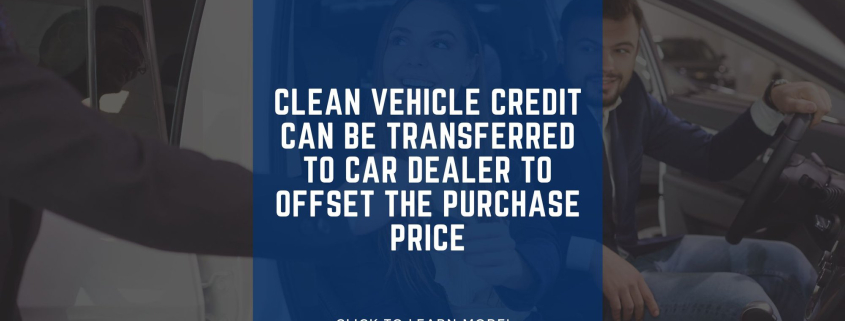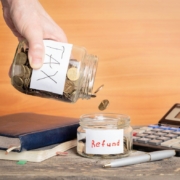Clean Vehicle Credit Can Be Transferred to Car Dealer to Offset the Purchase Price
- Learn about a new tax credit that can reduce the purchasing price of a new or qualified pre-owned car.
- Review the qualifications for receiving this tax credit.
Beginning in 2024, a special election allows a taxpayer purchasing a new clean vehicle or previously owned clean vehicle, to transfer the allowable credit to an eligible (registered) dealer. The dealer in turn applies the credit to the purchase of the vehicle. In short, the tax credit can be applied to reduce the cost of the purchase. This makes it easier for taxpayers to meet down payment requirements and avoids waiting for the credit until their tax return for the year of purchase is filed.
The federal government will reimburse the dealer for the credit amount that is applied to the purchase.
A buyer choosing to transfer the credit to the dealer is not mandatory. Taxpayers can still choose to claim the tax credit on their return instead of transferring a new or previously owned clean vehicle tax credit to the dealer. However, should a taxpayer choose to transfer the credit to an eligible dealer, several issues should be considered before making that decision.
Does The Vehicle Qualify for Credit?
Someone shopping for credit-qualified vehicles may wish to first determine which vehicles, both new and previously owned, qualify for credit. The following websites will provide that information.
- New vehicles qualifying for credit are provided by The Department of Energy.
- Previously owned clean vehicles ****qualifying for credit is provided by the IRS.
Qualified vehicles must also have prices below certain caps. For new vehicles, the manufacturer suggested retail prices (MSRP) must be below $80,000 for SUVs, vans, and trucks and $55,000 for others. For a previously owned clean vehicle, the dealer price must be $25,000 or less. In addition, a previously owned clean vehicle must be a model that is at least two years earlier than the calendar year in which the taxpayer acquires it.
Taxpayer Qualifications
First and foremost, a taxpayer needs to make sure they qualify for a credit. The credit limits the income of the buyer that can qualify for a credit, and these limitations are different for new clean vehicles and previously owned clean vehicles. If their modified adjusted gross income (MAGI) is even $1 over the limit, the taxpayer will not qualify for the credit. Taxpayers can use the MAGI from either their 1040 return for the purchase or the return for the previous year. Thus, if purchasing a vehicle in 2024, either the 2023 or 2024 MAGI can be used. The MAGI limitations are illustrated in the table below.

MAGI is usually the same as AGI on line 11 of the 1040. Exceptions include foreign income exclusions added back. If buying a used clean vehicle, the buyer must not be dependent or have claimed this credit in the past 3 years. If a credit is transferred but the taxpayer doesn't qualify, it must be repaid that tax year. No forgiveness provisions exist, potentially causing unexpected financial hardship.
Applying for the Credit Transfer
The taxpayer gives the necessary information to the dealer. The dealer submits it to the IRS for approval. Funds transfer to the dealer within 48 to 72 hours if approved. Dealers get real-time confirmation of advance request status online. If rejected, the taxpayer can't claim the credit. Both should be confirmed before finalizing sales.
The purchaser information needed to be submitted includes:
- Date of the transfer election.
- Taxpayer identification number (generally the taxpayer’s Social Security number).
- A photocopy of a valid government-issued photo identification document (such as a driver’s license or passport).
- The following attestations:o That either MAGI for the prior year OR the current did not exceed the limits. If not known, then to the best of their knowledge it will not exceed the limits. For new clean vehicles, the vehicle will be used predominantly for personal use or previously owned clean vehicles, and the qualified buyer requirements are met. An income tax return will be filed for the taxable year in which the vehicle is placed in service with proof of certain qualifications. Before placing the vehicle in service, this is the first or second transfer election made during the taxable year. If the MAGI limits are exceeded, the advance credit will be repaid for the tax year the vehicle was placed in service. The credit transfer was voluntarily elected.
Change of Mind
Once the sale is finalized, the taxpayer cannot change their mind about whether to transfer the credit to the dealer.
About the Credit
The clean vehicle credits are non-refundable and there is no carryover. Non-refundable means it can only offset a taxpayer’s tax liability on their tax return for the year claimed, and any excess is lost.
In addition, where the taxpayer has the credit transferred to the dealer, the IRS says you can’t transfer a partial credit, it is all or nothing. For a taxpayer in this situation, it may be more appropriate to just wait and claim the credit when they file their tax return. In doing so they avoid receiving the full benefit of the credit through the dealer and having to repay a portion. Whereas by claiming the credit on the tax return they only get credit for the amount they are entitled to.
As you can see there is a lot to consider related to the new and previously owned clean vehicle credit.
If you have questions or need assistance, schedule a consultation with a Fiducial advisor at https://fiducial.com/consultations.
Know someone who might need our services? We love referrals!









